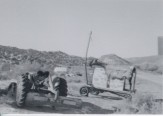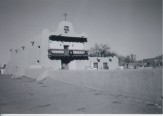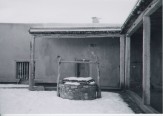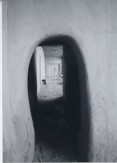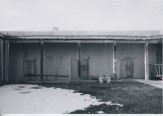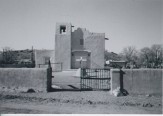2011–2012 Fellowship Recipients
Pamela Lucia Cabrera Pardo | Washington DC; Lima, Peru
Jae Won Chang | Yeonpyeong Island, South Korea
Jessica Helen Russell | Pueblos Communities, NM
Daniel E. Wills | Cuba
Projects
-
Daniel Wills
-
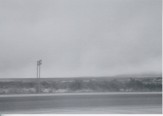
Jessica Russell
-

Jae Won Chang
-
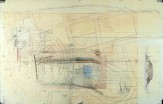
Pamela Cabrera
Back
Daniel Wills
The William Cooper Mack Thesis Fellowship granted me the opportunity to travel to Cuba to study and map the urban agrarian culture currently thriving in many Cuban cities, in order to bring back lessons and models of invention to the U.S. agrarian system. The Fellowship not only granted me the financial ability to make this study possible, but also the legal ability—without this educational grant, official travel to Cuba as an American citizen would not have been possible.
Originally my plan had been to travel to Havana and Cienfuegos, two of the largest urban farming cities. While this goal was still accomplished, my travels took me all over the island, studying not only the dense infrastructural, agrarian fabric of cities, but also the more rural, traditional farming communities like Vinales. With this rich travel schedule, I was able to see all aspects and degrees of agrarianism in Cuba.
Traveling around these various cities taught me about the infrastructure of food and how it produces new patterns of community organization and economies based entirely on the many varieties of land production. By patterns of community organization, I refer to the multiple scales of urban farms, markets, cafeterias, mobile food vendors and family-run restaurants. By land production, I refer to the farms that both produce and sell, but also everything from produced soils, compost and humus, to seeds, animal feed, oils and herbs – even the technologies of organic farming.
During my trip I had the opportunity to volunteer on an organoponico (organic urban farm) in Alamar, a Soviet-designed housing block community outside Havana. For three days I worked on various tasks, from planting seeds, to harvesting vegetables and plowing the soil for the next planting. The organoponico is completely efficient in the way it handles all resources across the 11 hectares of land. The farming system does not rely on any external inputs and produces an economy from its productive landscape, at the same time striking a balance with the resources.
My experiences in Cuba had a direct impact on my thesis, which focuses on industrial agrarianism in the Great Plains of the United States, a region threatened with the cumulative adverse effects of resource extraction. With Cuba able to do so much with so little, my hope is that the U.S. can begin to strike a balance with its own resources, before it’s too late.
Jessica Russell
During my trip and investigation into the Pueblo communities of the North West I visited the Tewa Pueblos of San Ildefonso (Po-Who-Ge-Oweenge – Where the Water Cuts Through), Santa Clara (Kha’p’oo Owinge – Valley of the Wild Roses), San Jaun (Ohkay Owingeh - place of the strong people), and Laguna Pueblo (Ka’waika – Lake). I slept in an Adobe style house where the mud, brick, and stucco coated walls were so thick and insulated that all the warmth generated from the house was kept within and the cold from outside was kept at bay.
Throughout this trip I gathered source material in the form of photographs, writings, and books (mostly all out of print) that I gathered from second hand books stores scattered throughout New Mexico as I followed the Rio Grande and crossed the state from west to east and then again, from north to south.
Throughout my journey I pursued the question I had begun investigating through my thesis in Australia—of the nature of an archive. What should become of valuable cultural information, which documents generations of memory, of histories and traditions that are stored, safely yet out of view and out of reach from all those who stand to benefit from the lessons they hold? The past offers not a retreat from the present but can offer resolutions for the future.
Looking at the pueblos of New Mexico and their relationship to the Rio Grande, I was able to identify an issue that had always seemed to me a problem with the Australian conception of space and built form. Without a strong tradition of permanent inhabitation and built typologies (although there were some) it is hard for contemporary architecture to not only build in relationship to a unique tradition, but to have the friction between past and present – for a break in continuity is equally dependent on a past as is the continuity of tradition. With no architectural past to rub against it is hard to carve out a future. I felt that in taking all the lessons and inspiration I gained from New Mexico I was able to go back to my origins and begin to ask the question that I believe holds a key to addressing these issues in Australia; the relationship between site, program, and structure. There is no richer case study of this method of architectural investigation and inquiry as the Pueblos of New Mexico.
The Cooper Mack Fellowship, not only enabled me to focus my thesis investigation but it opened the door to future investigations I intend to pursue beyond my time at Cooper Union.
Jae Won Chang
My thesis involved an in-depth analysis of Yeonpyeong Island in South Korea. The island is located off the west coast of the Korean Peninsula, only 3.6 kilometers from the internationally regulated Limit Line between North and South Korea. In order to pursue constructive research, I had arranged a meeting with an associate from the Republic of Korea Marine Corps before my departure, as the island is a designated military surveillance territory for the Korean government. The marine soldier who greeted me became my escort for the rest of my stay.
Though my survey of the Marine Corps base camps, I was able to witness the actual destruction and damage that occurred during the 2010 North Korean bombardment of the island. The punctured walls and ceilings, along with shattered windows of the buildings, spoke silently of the countless explosions caused by the missiles. According to the marines, some portions of the buildings were excluded from the reconstruction plan in order to preserve that historic moment.
Having seen the significant presence of North Korea through this tragedy, I also had the opportunity to learn about the ongoing dispute between the North and South over the island's coastal border. This included accounts of northern fugitives who had crossed the North – South border via fishing boats to land on the island and take up residence there. Although the island falls under the jurisdiction of the South, the ongoing attempt by North Korea to redraw the Limit Line has created a permeability of the island's boundary. This understanding helped me realize the potential for redefining the identity of Yeonpyeong Island through my thesis.
As part of my research, I made visits to several restricted areas, including closed beaches that were only accessible by military personnel. Likewise, certain regions—especially the northern shores of the island—were strictly controlled by the military, and mostly inaccessible by civilians. Such restrictions created a rather unusual demographic distribution, concentrating the settlements within the southeast part of the island, which is protected by the adjacent mountain range and far from the military sites.
Overall, surveying Yeonpyeong Island and studying its unique nature led me to ultimately redefine the island in a larger context, and articulate an architectural proposal. Unlike the existing identity of the island as South Korean territory, I began to reconstruct it as a neutral territory, an extension of the Demilitarized Zone. The analysis of topography, demography, major circulation and restricted spaces, as well as the aftermath of tragedy, became potential factors for a new architectural intervention of neutrality.
Pamela Cabrera
Pamela’s fellowship supported her trip to Lima, Peru where she investigated the contraposition of historical time, event time, and superimposed arbitrary time, and their effect on the city’s development. The site of her thesis was the longitudinal line 77'2' W of Greenwich Mean Time, which crosses the center of Lima within a single time zone (-5R) that connects the Americas as a whole continent, linking North America’s east coast with South America’s west coast. The abstract line 77'2' W exposes the expansion of Lima from a Spanish cuadricula to its littoral edge. Pamela’s thesis focused on juxtaposing a forgotten ruin and the modern, cartesian city to reestablish the present by introducing an archive, for the space of memory; a tower, for the space of observed time; and a plaza, for the space of public time.




